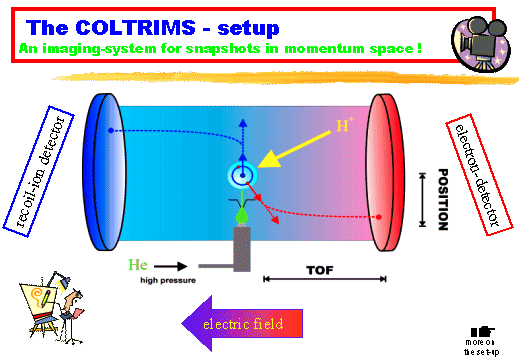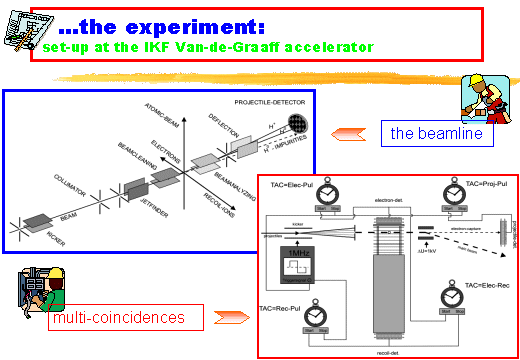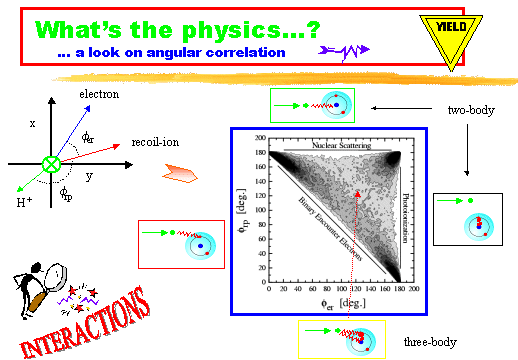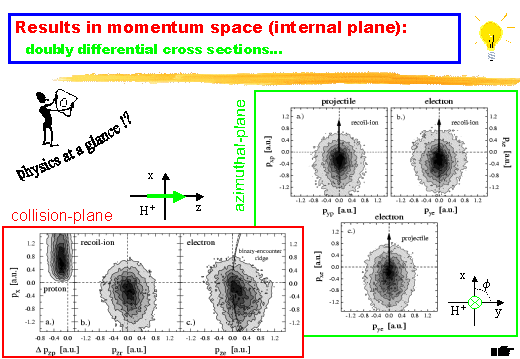Kinematically complete investigation of momentum transfer
for single ionization in fast proton helium collisions
|
publication ABSTRACT The dynamics of singly ionizing proton-helium collisions have been studied experimentally for several energies of the projectile (0.2, 0.5, 1.0 and 1.3 MeV) with the technique of COLd Target Recoil Ion Momentum Spectroscopy (COLTRIMS). The complete final-state distribution in momentum space of all three particles was determined by measuring the three momentum components of the emitted electron and the coincident recoiling target ion. The momentum transfer and energy loss of the outgoing projectile was determined by momentum and energy conservation laws. Doubly differential cross sections of the kinematically complete experimental investigation are presented. The present data are compared with results from fast highly charged heavy-ion impact experiments. INTRODUCTION The understanding of kinematical details of the ionization processes by charged particle impact still remain a challenge in atomic physics. Great insights in the various contributing mechanisms have been gained from ionization cross sections doubly differential in kinetic energy and emission angle for the ejected electrons (see [1] for a review). However, a complete investigation of the collision dynamics describes the interaction of all particles before, during and after the ionization process. Due to their small mass and the significant role they play in molecular binding, the behavior of the low energy electrons received most of the attention [2]. EXPERIMENTAL METHOD The experiment was performed at the 2.5 MV Van-de-Graaff accelerator of the Institut für Kernphysik of the University of Frankfurt. The pulsed ion beam and the atomic gas jet intersected in the center of the combined recoil-ion and electron momentum spectrometer (see figure 1 and 2). From the collision zone the recoiling target ions and electrons were extracted by a homogeneous electric field (60 V/cm) perpendicular to the plane of the incident beam and the target gas jet. After travelling through a short acceleration range (20 mm), the electrons were projected onto a position-sensitive detector. The recoiling ions passed through an electrostatic lens before drifting through a field-free region to another position-sensitive detector. From the position and time-of-flight, we derived the longitudinal and the transverse components of the final-state momentum of both electrons and recoiling ions. The electron measurement had a solid angle of 4p for a longitudinal momentum of up to 1.2 a.u. The high electric field and pulsewidth of the proton-beam resulted in a momentum resolution of 0.5 a.u. for the recoil-ions in all three dimensions. While the momentum resolution of the electrons in the electric-field direction (x-axis) comes to 0.5 a.u. too, the resolutions along the other axis are better than 0.03 a.u.  FIG. 1: Electron and Recoil Ion Momentum Spectroscopy was used in order to image the single ionization of helium. The electrons and the ions were guided on position sensitive detectors applying an electrostatic and magnetic field. From Time of Flight (TOF) and the position on the detectors the momentum vector of the outgoing particles could be determined.
 RESULTS AND DISCUSSION
The method of COLTRIMS delivers the final state of target ionization in a nine dimensional momentum space. Therefore one obtains the square of a three-particle wave-function in the continuum.  FIG. 3: Red box: Experimental longitudinal momentum distributions of the recoil-ions (dotted), electrons (solid) and the loss in momentum of the protons (dashed) for two different kinetic energies of the incident projectile: (a) 1.3 MeV/u and (b) 0.2 MeV/u. The losing of momentum of the proton is calculated via energy and momentum con-servation. The cuts in the electron distributions are due to the small angular resolu-tion (smaller than 4 p). Green box: Transverse momentum distributions of the recoil-ing ions (squares), electrons (diamonds) and projectiles (triangles) for single ionization of helium with protons (500 keV kinetic energy). The transverse projectile momentum is directly associated with the scattering angle (see upper scale).
In order to explore and understand the mechanisms leading to single ionization of the target, it is instructive to plot the azimuthal angle correlation between all particles. We plot the data as a function of the azimuthal angle between recoil ion and projectile frp versus the angle between recoil ion and electron fre. The distribution (Fig. 4) has the shape of a triangle. Events localized along the three sides of the triangle correspond to three different two-body interactions. The right-hand side reflects all events where the electrons and the recoiling ions were emitted back-to-back, while the proton momentum is uncorrelated and therefore the azimuthal angle frp can vary between 0° and 180°. This characterizes the dynamics of a photoionization process in which nearly no momentum is transferred to the target system and the atomic fragments compensate each other's momentum resulting in back-to-back emission of photo-electron and ion. The horizontal side on top of the triangle qualifies nucleus-nucleus interaction. Now the projectile and the recoil-ion are emitted back-to-back with an azimuthal angle of frp = 180° and the electron acts as a spectator. The diagonal defined as frp = 180°- fre represents the two-body interaction between electron and projectile. While the sides of the triangle qualify pure two-body interactions the pattern in between represents momentum exchange between all participating particles and therefore describes the dynamics of a correlated three-body system. Due to momentum and energy conservation, events outside of the triangle are forbidden. As displayed in Fig. 4 (for a kinetic energy of 1.3 MeV for the proton) binary-encounter collisions are the most probable processes leading to single ionization of the target atom. The distribution shown in Fig. 4 is in striking contrast to the corresponding distribution for highly charged ion impact [3]. There, most of the counts are located along the fre = 180° line, indicating the dominance of dipole transitions (see also [2]). 
Furthermore one can take a look at the full 3-body-dynamics by investigating double differential cross-sections in momentum space of all outgoing particles of the collision (see fig. 5). All the features can be clearly seen at a glance: It is evident that the proton exchanges significant momentum with the electron as well as with the target-nucleus; the transverse momentum transfer to the projectile indicates the three-body interaction. Nevertheless, there are a certain number of events that show a recoil-ion and electron emission in the same direction as the incident particle. The momentum-distribution of the electron approaches the well-known ridge of the binary-encounter processes, which are located on a circle around the velocity of the incident proton in fig. 5c (red box). For events along this line the electron balances the main part of the momentum loss of the projectile, while the recoiling ion nearly stays at rest.  CONCLUSIONS
The method of COLTRIMS has been applied successfully for the investigation of single ionization of helium by proton impact. We obtained a kinematically complete picture of the ionization dynamics for fast proton collision unprecedented in completeness and detail. This experiment fits in the experimental studies of single ionization of helium with charged particles. It is a linkage between ionization by slow proton impact ([8], [9]) and single ionization by fast highly charged ions ([2], [3]). [1] M.E. Rudd, Y. Kim, D.H. Madison and T.J. Gay, Rev. Mod. Phys. 64, (1992), P. 441 [2] N. Stolterfoth, R.D. DuBois and R.D. Rivarola, Electron Emission in Heavy Ion-Atom Collisions, Springer-Verlag Berlin, Heidelberg, (1997) The full story is also available as a talk! |